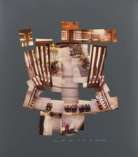
Shoes, Kyoto

Shoes, Kyoto
Signed Print
David Hockney
£40,000-£60,000
$80,000-$120,000 Value Indicator
$70,000-$110,000 Value Indicator
¥380,000-¥570,000 Value Indicator
€45,000-€70,000 Value Indicator
$410,000-$620,000 Value Indicator
¥8,310,000-¥12,460,000 Value Indicator
$50,000-$80,000 Value Indicator
There aren't enough data points on this work for a comprehensive result. Please speak to a specialist by making an enquiry.
76 x 66cm, Edition of 15, Photographic print
Auction Results

Track auction value trend
Meaning & Analysis
This 1983 signed print is by much-loved British artist David Hockney and was released in an edition of 15. Part of the Photo Collages collection of works, it depicts the entrance to a traditional Japanese ‘Minka’ home complete with a neatly-arranged line of shoes. At the bottom of the composition, we see Hockney’s shoeless feet.
Shoes, Kyoto is a signed print by British artist David Hockney produced in 1983. Comprising many individual photographs of the same Japanese ‘Minka’ home depicted in other examples of Hockney’s ‘joiner’ or photo collage pieces, namely Gregory Reading In Kyoto (1983) and Gregory Watching The Snow Fall, Kyoto, Feb 21st 1983 (1983), it portrays a threshold complete with sliding doors. A line of neatly arranged shoes are positioned at the bottom of the composition alongside Hockney’s shoeless feet. Here, in a whimsical mode characteristic of Hockney’s wider œuvre, the artist passes comment on Japanese traditions; here we are witness to Hockney positioning himself on the inside of the home, in an area where custom prohibits the wearing of shoes, looking out towards an area where they are commonplace. Offering a fish-eye-like view of both the interior and exterior of the building, this piece stretches the perspectival and focal limits of traditional photography, allowing the viewer to essentially be in two places at once. Harnessing the representational potential of a new approach to the camera which had formed the basis of a public lecture Hockney gave at London’s Victoria & Albert Museum in the same year, the artist fights back against the ‘lifeless’ singular image and its primacy within the artistic productions of the era.